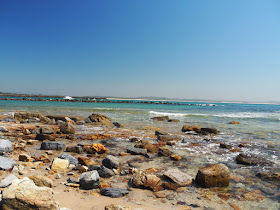A trellis is usually taken to be a light framework of wooden
or timber bars, fastened where they cross, producing a screenwork of square or
diamond-shaped gaps, generally filling a window or door space, and it gets its
name from the trilicium, a Latin term
for a warp thread made of three separate threads. Variant forms of this word
are found in Middle English and Old French, but these days, people are more
likely to speak of a lattice.
This is much the same thing as a trellis, but made from a
thin wooden strap, a lath. This comes from the Old English lætte, through the Middle English laþþe, a word that was still in use in Shakespeare's time, when
Falstaff declares to Prince Hal that he will "beat thee out of thy kingdom
with a dagger of lath" in Henry IV
Part 1, and it is a word which may still be heard in the expression 'lath
and plaster'.
There is a similar word in German, laden, meaning a counter or shop, probably derived from the sense
of lath as a plank, used to make a counter in a market place, but ladders were
never made from lath, and even though ladders were often used in a barn, they
have nothing to do with what Chaucer called variously a lath and a lathe,
meaning a barn.This name comes from the Old Norse word hlaða, which is also seen in the rare verb 'lade', meaning load,
and still seen in the past participle, 'laden'.
In times gone by, Kent was divided into a number of lathes,
each with a lathe reeve, a bit like the shire reeve who gave us our modern
sheriff, but what of the lathe that we use to turn wood and metal? The standard
explanation ties this to the hlaða
and 'lade', on the basis that this is similar to the Danish 'lad', a stand,
seen in compounds such as savelad, a
saw-bench, and væverlad, a loom
(think /weaver-stand' to get the feel for this one).
Along this line of reasoning, the 'lad' is a pile built up
in a regular way to make a stand, and so the lathe was a turning-lathe or
turning-stand, and so became just a lathe. The fact that this is a little
improbable has been happily ignored by etymologists in the past. It is just
possible, though, that etymologists are less interested in technology than in
words, and may have missed another possibility.
 While we now use electric power, and before that, people
used steam or even water-power to drive a lathe, in the middle ages, a lathe
used a long and whippy arm over the bench, a treadle below, and a strap that
went around the timber being worked. As the treadle went down, bending the
boom, the strap made the timber piece turn.
While we now use electric power, and before that, people
used steam or even water-power to drive a lathe, in the middle ages, a lathe
used a long and whippy arm over the bench, a treadle below, and a strap that
went around the timber being worked. As the treadle went down, bending the
boom, the strap made the timber piece turn.
Then when the treadle was released,
the strap spun the timber in the opposite direction. Now the bending part of an
arbalest or crossbow is called a lath, and it is just possible that our modern
lathe was once a turning-lath, instead, or maybe the two ideas got mixed up.
One major use of lattice in the past was to make chancels,
screens used to separate officiating clergy from the masses, or a court from
the general public. The chancel, and what lay beyond, would be guarded by a
chancellor, who was basically just an usher at the bars (chancelli) of a court.
But while constables were coming down in the
world, the fortune of chancellors was on the rise, and soon they were Lord
Chancellors, lording it over just about everybody, controlling whole
universities, and even having courts of their own, the Chancery courts that
Dickens depicts so lovingly in Bleak
House.
These courts were every bit as awful in their behaviour as
Dickens describes them, so that pugilists used the expression 'in chancery' to
describe a fighter who had his opponent in a headlock, while beating him in the
face with his spare fist. It would be enough to get you in a lather, but that,
it seems, is an unrelated word.




















